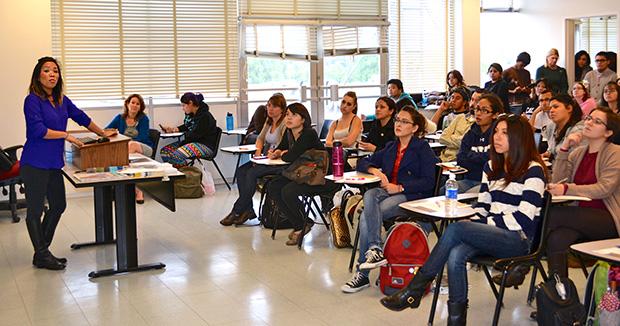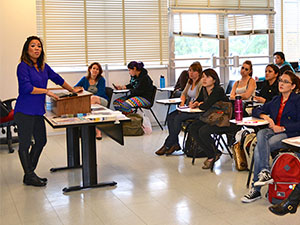
A representative from the CSU Health Insurance Education Project (HIEP) educated more than 50 CSUN students about the Affordable Care Act (ACA), known as Obamacare, and Covered California.
“Covered California is the state’s marketplace to compare plans, qualify for subsidies and purchase coverage,” said Celina Chaunsumlit, CSU HIEP’s regional coordinator of Southern California.
Many students who attended the forum were confused regarding how Obamacare applies to them, and hope the lecture will make them become better acquainted with Covered California, how it affects them, and what the penalty will be if they do not purchase health care within the given deadline.
“I was confused because I heard mixed reviews about Obamacare,” said Anna Avetisyan, 23, linguistics graduate student. “I heard that it could be expensive and since it will be a requirement I want to be more informed about the options.”
Covered California is not a health insurance company that offers its own plans. Chaunsumlit explained that consumers who go through Covered California will still be purchasing insurance from a private insurer. However, through Covered California consumers can search for the plan that is most compatible for them and the government will pay a portion of the fee.
“The defining characteristic of Covered California is that (it) is the only place to qualify and obtain premium assistance,” Chaunsumlit said.
Premiums are what consumers pay per month in order to have health coverage. Assistance is the amount of help that the government will provide to consumers contingent upon their income and the plan (tier) they purchase.
Chaunsumlit explained that Covered California offers four different tiers of coverage: bronze, silver, gold and platinum. Lower tiers such as bronze and silver come with higher consumer costs, whereas higher tiers are offered more government assistance.
For example, a 21-year-old with an income of $18,000 within the LA area will pay a monthly premium of $191 under the silver plan. The silver tier offers a premium assistance of $140, meaning the individual will only pay $51 a month for health insurance. Although rates fluctuate depending on where an individual lives.
If Americans do not have health insurance by Jan. 1, 2014 they will have to pay a penalty fee.
“The mission of Covered California is to provide quality and affordable health insurance,” Chaunsumlit said. “There is transparency within the marketplace. Rates are revealed, premiums and copayments are noted and pricing plans (are available).”
Chaunsumlit anticipates that a large number of CSU students will qualify to receive extra government assistance (subsidies) under Covered California.
People who make the federal poverty line (FPL) will qualify for subsidies, extra government assistance.
Other students echoed Avetisyan’s reason for attending.
“I wanted more information on how to be covered by Covered California,” Cindy Sanchez, 25, a senior studying public health said. “I wanted to understand how to get health insurance for me and my family.”
Adolfo Valdivia, 23 and a senior studying finance, wanted to understand what Obamacare and Covered California really was.
“Right now I am not insured,” Valdivia said. “I wanted to see what benefits (Covered California) offers and to see if I qualify for them.”
Chaunsumlit said that everyone will not qualify for Covered California. Those who are extremely wealthy may make too much money and will have to seek health care from private insurers.
“Not everyone knows what (Obamacare) is and how to gain access to quality, affordable healthcare,” Chaunsumlit said. “I was impressed with the turnout, it demonstrates that this is important to students. They are eager to learn more about ACA for themselves and family.”
Covered California representatives will be coming back to CSUN to speak again Wednesday at 12 p.m. and 7 p.m. For more information visit the Covered California website or the CSU Covered California website.





